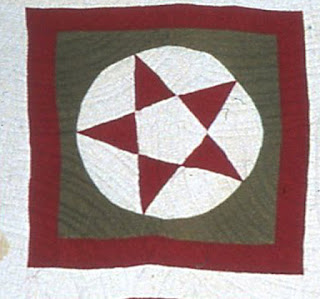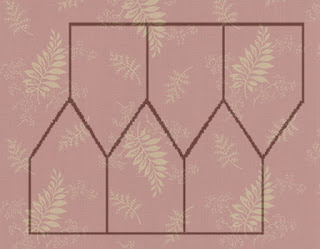Five-pointed stars can contain pentagons, which is where
quilters usually encounter the regular five-sided shape.
Silk Quilt, about 1880
From the Collection of the Museum of American Folk Art
Regular pentagons cannot tile a plane.
Actual tiles
Detail of a silk quilt from Sue Reich's lecture:
Susie C. Walker: Her Life and Quilts in a 19th Century
Connecticut Silk Mill Company Town.
Detail from a mid-19th-century album sampler.
Quilt from the Paquette Family
Wisconsin Historical Society, 1993.51
If you want to work with regular pentagons and five-pointed stars...
Millefiori Quilts
you need to add other pieces to get the design to fill out.
Penny Tucker's version of Willyne Hammerstein's
Passacaglia
The piecers who are working on Willyne's Millefiori quilts will be only to glad to tell you how many different shapes can go with a regular pentagon.
But irregular five-sided shapes will tessellate---that is cover a surface with a single shape.
The house shape has potential.
In EQ7 you can set up a quilt with a one-patch layout in this 5-sided shape.
You can make the house a three story row house
or a suburb of bungalows.
Here's the perfect example in a Mennonite quilt
from dealer Stella Rubin.
The houses don't have to line up on streets.
(I have no sewing advice here.)
Another irregular 5-sided shape that might make
a good charm quilt.
Quilt by Mahala Pinney, last-quarter 19th-century.
Collection of the British Quilt Museum.
It's the same modified hexagon shape as the prints in this British quilt (Don't let the red hexagons distract you.) See the quilt here:
Even though nature loves the number 5---quiltmakers ---not so much.
See the Mathematical Tourist blog on tiling with pentagons:
https://plus.maths.org/content/trouble-five






















Cool!!!!!!!!!!!!!!!!!
ReplyDelete